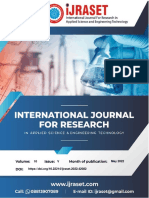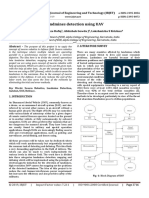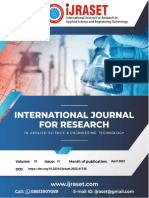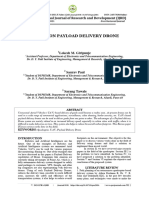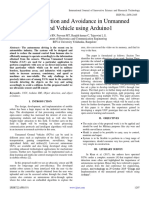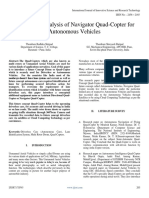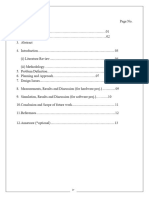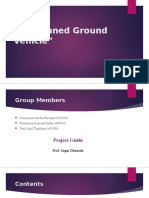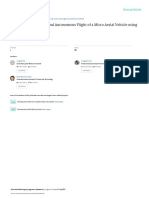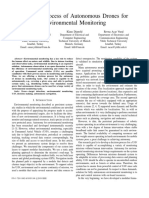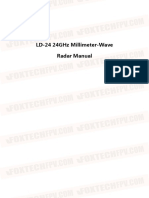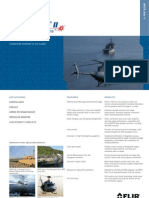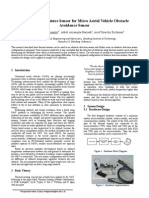Professional Documents
Culture Documents
Design and Implementation
Copyright
Available Formats
Share this document
Did you find this document useful?
Is this content inappropriate?
Report this DocumentCopyright:
Available Formats
Design and Implementation
Copyright:
Available Formats
Volume 5, Issue 4, April – 2020 International Journal of Innovative Science and Research Technology
ISSN No:-2456-2165
Design and Implementation of
Quadcopter for Surveillance Application
Dr. Nagesh K N 1, Professor and HOD M. Kiran mayee2, Student
Department of Electronics & Communication Engineering Department of Electronics & Communication Engineering
Nagarjuna College of Engineering & Technology Nagarjuna College of Engineering & Technology
Bengaluru, India Bengaluru, India
Shaik Altaf 3, Student Siddaram jagadi 4, Student
Department of Electronics & Communication Engineering Department of Electronics & Communication Engineering
Nagarjuna College of Engineering & Technology Nagarjuna College of Engineering & Technology
Bengaluru, India Bengaluru, India
D Vaishnavi 5, Student
Department of Electronics & Communication Engineering
Nagarjuna College of Engineering & Technology
Bengaluru, India
Abstract:- The main purpose of the project is to design propel the aircraft. By changing the speed of the motors,
and implement a system that will be useful for the scheme of controlling a Quad-copter is done with
surveillance applications. Surveillance is the process respective to each other, also the forces of the Quad-copter
where a particular object or place or a thing is closely wants real time movement of the motors. To obtain a
observed. Quad-copter, an unmanned aircraft system balanced flight, integration of the control system is needed
consisting of Camera, Brushless DC motors, and a kk controller board will give the control algorithm
Accelerometer, Gyroscope, Propellers, controller and will be able to receive and send commands. Till 1996
together form an Ariel vehicle, which is used for the UAV Quad-copter was used only in military applications.
surveillance work. This Quad-copter is also used in the When the improvement of advanced capable electronics,
military reconnaissance, Commercial usage, Civilian which ranged very powerful, very less weight
application and in many more industrial and rescue microcontrollers to very small sensors with better required
missions. In this project we are designing and accuracy and precision, we can design a quad-copter with
developing a semi-autonomous quadcopter capable of requires sizes and can be used for different applications.
self-sustained flight via wireless communication while Several advantages are there for A Quad-copter when
using a micro-controller board and controlling the compared to the other unmanned aircrafts such as its
motions of the quadcopter remotely by observing the quality of moving freely even in the stiff wind and its
streaming video along with joystick. The project functionalities and the power in controlling the speed of the
designed with low complexity, hence cost effect would motors for the required one. Also, these aircrafts make less
be minimized. harm to the humans, as we added protective frames to cover
the exposed propellers. By these aircrafts we can even
Keywords:- KK Multicontroller Board, DC motors, ESC’s, eliminate many fire accidents, explosions and electrical
Propellers, Sensors. based incidents. These aircrafts also used to avoid criminal
activity and others.
I. INTRODUCTION
II. RELATED WORK
A quad-copter is an unmanned aerial vehicle capable
of flying autonomously. These can be controlled remotely M. Alwateer, S. W. Loke and N. Fernando [1], As
via a remote-control system (RC), though controlling drones are way more useful in civilian applications these
aircraft autonomously or semi-autonomously is constantly are mostly networked, enabling their remote programming
monitored. This movement of the aircrafts without any setup and in the control of humans. However, drones are
interference of a person inside it can be done through the limited to their capable carriage weight and battery power
pre-programmed flight, which uses global positioning is limited too. With use of nearby devices (i.e. with
system, it also depends on it and it can be achieved by additional smart resources other than drones’ abilities) and
combination of ultrasonic sensor. Various UAV sizes and controlling multiple drones is more convenient method to
shapes can be chosen. Most benefited application is in overcome these limitations in advance. With the study
Military, but these unmanned aircrafts are also programmable crowd-powered drones, involving two key
implemented in various applications. A unique kind of concepts for combining drones and smartphones or a smart
UAV's which uses four-fixed rotors is Quad- copter, per device as a crowd-powered resource cloud is detailed. In
axis two rotors are used (each axis is aligned orthogonally particular, this study focuses on crowd-sourcing for drone
with the other), the lift is powered by four motors and computations which are complex, and multi-drone data
IJISRT20APR625 www.ijisrt.com 833
Volume 5, Issue 4, April – 2020 International Journal of Innovative Science and Research Technology
ISSN No:-2456-2165
processing management using an advanced scripting range is low detailed study of automated drone control is
language for coordinated flight paths of multiple drone’s useful. Study of multiple drone data processing and sensor
technology. calibration is obtained for secured flight control. The study
of performance evolution is done. This drone has the ability
J. Engel, J. Sturm and D. Cremers [2], Low cost to recognize the patterns using its built-in camera and by
quadcopter builds and which can be controlled through the processing the captured image. A study on frame rate of
smart devices from the ground is studied in this paper, 100 msec per frame is done.
which features autonomous navigation in unknown GPS
environments. They have used three major components in J. R. Cauchard et al [4], Studied all the various tasks
the system, to navigate using simultaneous localization and offered to the people using drone technology such as
mapping all the components are calibrated and set for photography, surveillance and increase the social context.
detecting accurate data. Kalman Filter for data processing Studied about the interface design that is used by the user
and error correction, for data fusion and for state with ease and without any complexity in a natural manner.
estimation. For generation of commands proportional– This was the first drone which has general graphical user
integral–derivative controller. A PID controller is used for interface which is used by normal person. Studied the
which it calculates an error value e(t) continuously. design process of drone inputs and outputs. The full-
Mapping all the data we can obtain a scale of generated fledged functional prototype in guiding scenario is studied.
visual map with all the altitude measurements. We studied The simple user training technique is also studied in this
the system which is able to navigate in unknown paper. The way of human robot interaction is clearly
environments with proper scale and it is obtained without studied in this paper.
the use of external sensors. Its robustness in
communication, use of SLAM tech, accurate navigation is I. Bae [5], The study of replacement of person with a
studied. machine is done. The mobility factors are referred in
detailed. The telepresence platform that resembles the
N. Yamamoto and N. Uchida [3], High performance social humans of drone piolet design is studied. The
drone technology is studied. Which are having high vision extensions for the drome capabilities are detailed.
cameras and all the flight control sensors like gyroscope, IR Portability and compatibility are mainly focused. Easily
sensors, Global positioning system and a video processing manurable drone designs are studied in in this. Adding head
unit. Stable Flight is obtained by manual operations by and arms to the quadcopter design is explained clearly in
human control. As the human sight is not so accurate and this paper
III. METHODOLOGY
Fig 1:- Layout of Surveillance quadcopter
The layout of the surveillance quadcopter in fig 1 shows the algorithm in which overall working of the quadcopter is shown.
As of first when the user inputs or directions are given, they are received by flight control board through transmitter. All the
information will be transmitted to the ESC’s (Used to run the motors in the required speed), and from there to the DC motors. The
rotation of motors and the propellers make the quadcopter to hover. The sensors present in the KK board, Accelerometer and the
gyroscope (used to know the tilt of the drone).
IJISRT20APR625 www.ijisrt.com 834
Volume 5, Issue 4, April – 2020 International Journal of Innovative Science and Research Technology
ISSN No:-2456-2165
Fig 2:- System Architecture
The KK multi-controller, connected by the receiver and transmitter through the wireless remote controller. All the four
electronic speed controllers are connected to the KK board, which are used for controlling the speed of the DC motors ,which are
connected to the ESC’s, When we want the drone to fly for surveillance work, first we have to send information to the KK board,
through the transmitter and then controller sends the information to propellers, esc’s and the motors through the sensors used like
gyroscope and the accelerator. The user, who is using the remote can send the directions, in which drone have to move and all the
operations will be performed manually by wireless remote.
Fig 3:- Data flow diagram
IJISRT20APR625 www.ijisrt.com 835
Volume 5, Issue 4, April – 2020 International Journal of Innovative Science and Research Technology
ISSN No:-2456-2165
IV. WORKING [4]. J.R. Cauchard et al, "Drone.io: A Gestural and Visual
Interface for Human-Drone Interaction,"2019 14th
The combination Electronics, Mechanical will make ACM/IEEE International Conference on Human-
the Quadcopter work and mainly depends on the principle Robot Interaction (HRI), Daegu, Korea (South), 2019,
of Aviation. As stated, its main intention is to take care of a pp.153-162.
plane on the wing, these four forces operate the plane on [5]. I. Bae, "Avatar drone: Drone as telepresence platform
the wing are arranged. The motion of the air is compared to with 3D mobility," 2016 13th International
the generated plane two types of these forces. lift is the first Conference on Ubiquitous Robots and Ambient
one. The force which is produced will be directed towards Intelligence (URAI), Xi'an, 2016, pp. 452-453.
up and can act at right angles to the movement of the plane.
The plane is maintained within the air. is the Drag being the
second one. It is applied in the opposite direction to the
movement of the traditional plane. This is because of
opposing breaking action of the air on the horizontal and is
against the advance of the plane. As this maintenance of the
horizontal is by the action of the air due to the displacement
of the aircraft, the lift and also the drag are referred to as
aerodynamic forces. This force is due to gravity, the load of
the plane, is meant to the lift. The balance of the lift and
also the load results in constant altitude within the plane.
To confirm that the plane continues to maneuver forward, it
is necessary to produce a opposite force that compensates
for the force called drag. This force is termed as the thrust.
System of propulsion of the planes will generate thrust, the
engines. Within the case of the flight is at cruising speed,
the role of the engine is thus to make amends for the force
of drag, but not to make the plane mount. On the opposite
side, at the time of take-off, the altitude of flight is obtained
by the employment of engine power.
V. CONCLUSION
The “Surveillance Quad-copter” is a highly helping
system with the help of the wireless remote controller And
we can the live video over the areas which ever we want to
observe. It can also able to take the pictures by the camera,
whenever user gives the commands. This also helps to keep
a record of details of the incidents that happened at the
wanted areas. It will give us the live video and audio
transmission from the areas where we cannot go and access
the information. Overall specifications tell that all
approaches will be trying to provide better result in terms
of quality of the video and picture detection.
REFERENCES
[1]. M. Alwateer, S. W. Loke and N. Fernando, "Enabling
Drone Services: Drone Crowdsourcing and Drone
Scripting," in IEEE Access, vol. 7, pp. 110035-
110049, 2019.
[2]. J.Engel, J.Sturm and D. Cremers, "Camera-based
navigation of a low-cost quadrocopter," 2012
IEEE/RSJ International Conference on Intelligent
Robots and Systems, Vilamoura, 2012, pp. 2815-
2821.
[3]. N. Yamamoto and N. Uchida, "Improvement of Image
Processing for a Collaborative Security Flight Control
System with Multiple Drones," 2018 32nd
International Conference on Advanced Information
Networking and Applications Workshops (WAINA),
Krakow, 2018, pp. 199-202.
IJISRT20APR625 www.ijisrt.com 836
You might also like
- UNSC Field Manual - Halo RPGDocument11 pagesUNSC Field Manual - Halo RPGJoey Mullins100% (3)
- Hawk Eye Unmanned Aerial Vehicle For MonitoringDocument7 pagesHawk Eye Unmanned Aerial Vehicle For MonitoringIJRASETPublicationsNo ratings yet
- Design and Analysis of An Unmaaned Aerial VehicleDocument8 pagesDesign and Analysis of An Unmaaned Aerial VehicleDeb PradhanNo ratings yet
- UFC 3-600-01 - Design of Fire Protection Engineering For Facilities - Change 4 - 7 February 2020 PDFDocument204 pagesUFC 3-600-01 - Design of Fire Protection Engineering For Facilities - Change 4 - 7 February 2020 PDFMarkNo ratings yet
- Drone Oil & Gas Webinar: Inspection ApplicationsDocument56 pagesDrone Oil & Gas Webinar: Inspection ApplicationsIqfal ZulhendriNo ratings yet
- Landmines Detection Using UAVDocument4 pagesLandmines Detection Using UAVAnonymous zKvy2YnL9INo ratings yet
- Development of Modular Unmanned Surface Vehicle For Research and EducationDocument4 pagesDevelopment of Modular Unmanned Surface Vehicle For Research and EducationistancicNo ratings yet
- United SOPDocument7 pagesUnited SOPChase Morgan0% (1)
- Acquisition Proposal - Teledyne TechnologiesDocument110 pagesAcquisition Proposal - Teledyne TechnologiesAri EngberNo ratings yet
- Design and Development of Surveillance DroneDocument5 pagesDesign and Development of Surveillance DroneIJRASETPublicationsNo ratings yet
- Radar Guided Missile SystemDocument3 pagesRadar Guided Missile SystemVS JayarajNo ratings yet
- Addis Ababa University Addis Ababa Institute of Technology School of Electrical and Computer EngineeringDocument22 pagesAddis Ababa University Addis Ababa Institute of Technology School of Electrical and Computer Engineeringbegziew getnetNo ratings yet
- Accelerating Power Grid Monitoring With Flying Robots and Artificial IntelligenceDocument7 pagesAccelerating Power Grid Monitoring With Flying Robots and Artificial IntelligencebenlahnecheNo ratings yet
- AD Based On PhoneDocument11 pagesAD Based On PhoneRivasNo ratings yet
- 1159pm 20.epra Journals-6704Document7 pages1159pm 20.epra Journals-6704Akash ShevateNo ratings yet
- Object Detection and Avoidance in Unmanned Ground Vehicle Using Arduino1Document4 pagesObject Detection and Avoidance in Unmanned Ground Vehicle Using Arduino1International Journal of Innovative Science and Research TechnologyNo ratings yet
- Design and Analysis of Navigator Quad Copter For Autonomous VehiclesDocument3 pagesDesign and Analysis of Navigator Quad Copter For Autonomous VehiclesInternational Journal of Innovative Science and Research TechnologyNo ratings yet
- Cinematography Drone With Automated Ability For Self-Flight and ManeuverabilityDocument17 pagesCinematography Drone With Automated Ability For Self-Flight and ManeuverabilityIJRASETPublicationsNo ratings yet
- Drones 07 00682Document18 pagesDrones 07 00682ControlSI PeruNo ratings yet
- Design & Implementation of An UAV (Drone) With Ight Data RecordDocument7 pagesDesign & Implementation of An UAV (Drone) With Ight Data RecordAhmed MateenNo ratings yet
- Abbreviated UAV Cloud Integration Proposal - (Katende Marvin and Ayebare Anil Pelice)Document5 pagesAbbreviated UAV Cloud Integration Proposal - (Katende Marvin and Ayebare Anil Pelice)Marvin KatendeNo ratings yet
- Jeta V3i3p101Document3 pagesJeta V3i3p101Slakshmi NarayanaNo ratings yet
- Surveillance Drones and Their ApplicationsDocument4 pagesSurveillance Drones and Their ApplicationsAryan RautNo ratings yet
- Autonomous Drone For Defence MachineryDocument5 pagesAutonomous Drone For Defence Machinerymanjunathagari gayathriNo ratings yet
- PDF - Js Viewe5rDocument4 pagesPDF - Js Viewe5rPranoy MukherjeeNo ratings yet
- A Review On Applications of Rotary-Wing Unmanned Aerial Vehicle Charging StationsDocument20 pagesA Review On Applications of Rotary-Wing Unmanned Aerial Vehicle Charging StationsZakky NurshidiqNo ratings yet
- Design and Implementation of Autonomous Quadcopter Using SITL SimulatorDocument16 pagesDesign and Implementation of Autonomous Quadcopter Using SITL SimulatorstefanoNo ratings yet
- Sky Cargo: Self-Navigating Delivery DroneDocument7 pagesSky Cargo: Self-Navigating Delivery DroneInternational Journal of Innovative Science and Research TechnologyNo ratings yet
- 1st UTILIZE IN RISKY OPERATIONDocument17 pages1st UTILIZE IN RISKY OPERATIONJoseph Israel BagasinaNo ratings yet
- Internet Controlled DroneDocument7 pagesInternet Controlled DroneIJRASETPublicationsNo ratings yet
- Gesture controlled drone system (2)Document37 pagesGesture controlled drone system (2)DeeptanshuNo ratings yet
- Unmanned Ground Vehicle Final Completed 1Document25 pagesUnmanned Ground Vehicle Final Completed 1Guruprasad BhagwatNo ratings yet
- Paper (INTELLIGENT NIGHT SURVELLIANCE USING DRONE)Document7 pagesPaper (INTELLIGENT NIGHT SURVELLIANCE USING DRONE)Lohit DalalNo ratings yet
- 3D Smooth Random Walk Mobility Model for FANETsDocument13 pages3D Smooth Random Walk Mobility Model for FANETsPreethu GowdaNo ratings yet
- Review PaperDocument15 pagesReview Paperdre98makNo ratings yet
- GUI Controlled Aerial Drone: Kartik Panicker, Vaibhav Murkute, Deepak Padhi, Akash NarkhedeDocument3 pagesGUI Controlled Aerial Drone: Kartik Panicker, Vaibhav Murkute, Deepak Padhi, Akash NarkhedeerpublicationNo ratings yet
- DLSU ResCon 2017 Paper 110Document6 pagesDLSU ResCon 2017 Paper 110Ralph Laurence Garcia VisayaNo ratings yet
- A Short Review of The Drone Technology: August 2022Document17 pagesA Short Review of The Drone Technology: August 2022sarthak ghimireNo ratings yet
- Developing A Software For Autonomous Unmanned Aerial VehicleDocument5 pagesDeveloping A Software For Autonomous Unmanned Aerial VehicleInternational Journal of Application or Innovation in Engineering & ManagementNo ratings yet
- Paper TE-2Document8 pagesPaper TE-2Sandro SiagianNo ratings yet
- Drone Detection Through Live Camera Using YOLOv3Document8 pagesDrone Detection Through Live Camera Using YOLOv3Ayapilla Sri hari PranavNo ratings yet
- A Short Review of The Drone Technology: August 2022Document17 pagesA Short Review of The Drone Technology: August 2022rokomNo ratings yet
- Sensors 22 03418Document20 pagesSensors 22 03418gryzzlyNo ratings yet
- Autonomous Vehicle With Machine Vision and Integrated Sensor Suite Based On Internet-of-Things TechnologiesDocument13 pagesAutonomous Vehicle With Machine Vision and Integrated Sensor Suite Based On Internet-of-Things TechnologiesIvan CheahNo ratings yet
- Waypoint and Autonomous Flying Control of An Indoor Drone For GPS-denied EnvironmentsDocument17 pagesWaypoint and Autonomous Flying Control of An Indoor Drone For GPS-denied EnvironmentsIAES International Journal of Robotics and AutomationNo ratings yet
- Quadcopter Research PaperDocument5 pagesQuadcopter Research Papergmannevnd100% (1)
- Design and Development of Autonomous Ground Vehicle For Wild Life MonitoringDocument8 pagesDesign and Development of Autonomous Ground Vehicle For Wild Life MonitoringJeevan KumarNo ratings yet
- Spy RobotDocument7 pagesSpy RobotIJRASETPublicationsNo ratings yet
- TCALAS: Temporal Credential-Based Anonymous Lightweight Authentication Scheme For Internet of Drones EnvironmentDocument14 pagesTCALAS: Temporal Credential-Based Anonymous Lightweight Authentication Scheme For Internet of Drones EnvironmentHaseeb TahirNo ratings yet
- HGC Camera ReadyDocument9 pagesHGC Camera ReadySAHITHLAL HOWDEKARNo ratings yet
- Face Recognition On UAV AI DroneDocument6 pagesFace Recognition On UAV AI DroneInternational Journal of Innovative Science and Research TechnologyNo ratings yet
- 148 PDFDocument8 pages148 PDFAAS SHNo ratings yet
- Transmission Line Physical Inspection Robot Using Electrical Switch Gears and Embedded LogicDocument5 pagesTransmission Line Physical Inspection Robot Using Electrical Switch Gears and Embedded LogicIJRASETPublicationsNo ratings yet
- 10 1109@icisc47916 2020 9171187Document5 pages10 1109@icisc47916 2020 9171187jhoNo ratings yet
- A Survey On Open-Source Flight Control Platforms of Unmanned Aerial VehicleDocument7 pagesA Survey On Open-Source Flight Control Platforms of Unmanned Aerial Vehicle029Muhammad Robith Fikris SholihNo ratings yet
- IJRPR12924Document8 pagesIJRPR12924Lohit DalalNo ratings yet
- Microcontroller Based Missile Detection and Destroying SystemDocument3 pagesMicrocontroller Based Missile Detection and Destroying SystemNiranjitha HVNo ratings yet
- Development of Flight Controller Using STM Microcontroller BoardDocument5 pagesDevelopment of Flight Controller Using STM Microcontroller BoardaeroacademicNo ratings yet
- ITR Report 2Document33 pagesITR Report 2Sukanya DubeyNo ratings yet
- Design and Experimental Comparison of PID, LQR and MPC MamboDocument21 pagesDesign and Experimental Comparison of PID, LQR and MPC MamboPedro Cezar Rodrigues BaltazarNo ratings yet
- 3-D Indoor Navigation and Autonomous Flight of A M PDFDocument7 pages3-D Indoor Navigation and Autonomous Flight of A M PDFkhoamaiNo ratings yet
- Sensors 18 04363Document14 pagesSensors 18 04363UsdhdjdkNo ratings yet
- Decision Process of Autonomous Drones For Environmental MonitoringDocument6 pagesDecision Process of Autonomous Drones For Environmental MonitoringPeterPanNo ratings yet
- Comparative Study of Indoor Navigation S-1Document11 pagesComparative Study of Indoor Navigation S-1Jayashree T R 21PHD1140No ratings yet
- The Making of Self-Disposing Contactless Motion-Activated Trash Bin Using Ultrasonic SensorsDocument7 pagesThe Making of Self-Disposing Contactless Motion-Activated Trash Bin Using Ultrasonic SensorsInternational Journal of Innovative Science and Research TechnologyNo ratings yet
- Exploring the Clinical Characteristics, Chromosomal Analysis, and Emotional and Social Considerations in Parents of Children with Down SyndromeDocument8 pagesExploring the Clinical Characteristics, Chromosomal Analysis, and Emotional and Social Considerations in Parents of Children with Down SyndromeInternational Journal of Innovative Science and Research TechnologyNo ratings yet
- Intelligent Engines: Revolutionizing Manufacturing and Supply Chains with AIDocument14 pagesIntelligent Engines: Revolutionizing Manufacturing and Supply Chains with AIInternational Journal of Innovative Science and Research TechnologyNo ratings yet
- Advancing Opthalmic Diagnostics: U-Net for Retinal Blood Vessel SegmentationDocument8 pagesAdvancing Opthalmic Diagnostics: U-Net for Retinal Blood Vessel SegmentationInternational Journal of Innovative Science and Research TechnologyNo ratings yet
- Handling Disruptive Behaviors of Students in San Jose National High SchoolDocument5 pagesHandling Disruptive Behaviors of Students in San Jose National High SchoolInternational Journal of Innovative Science and Research TechnologyNo ratings yet
- Natural Peel-Off Mask Formulation and EvaluationDocument6 pagesNatural Peel-Off Mask Formulation and EvaluationInternational Journal of Innovative Science and Research TechnologyNo ratings yet
- Beyond Shelters: A Gendered Approach to Disaster Preparedness and Resilience in Urban CentersDocument6 pagesBeyond Shelters: A Gendered Approach to Disaster Preparedness and Resilience in Urban CentersInternational Journal of Innovative Science and Research TechnologyNo ratings yet
- Placement Application for Department of Commerce with Computer Applications (Navigator)Document7 pagesPlacement Application for Department of Commerce with Computer Applications (Navigator)International Journal of Innovative Science and Research TechnologyNo ratings yet
- Fruit of the Pomegranate (Punica granatum) Plant: Nutrients, Phytochemical Composition and Antioxidant Activity of Fresh and Dried FruitsDocument6 pagesFruit of the Pomegranate (Punica granatum) Plant: Nutrients, Phytochemical Composition and Antioxidant Activity of Fresh and Dried FruitsInternational Journal of Innovative Science and Research TechnologyNo ratings yet
- A Knowledg Graph Model for e-GovernmentDocument5 pagesA Knowledg Graph Model for e-GovernmentInternational Journal of Innovative Science and Research TechnologyNo ratings yet
- REDLINE– An Application on Blood ManagementDocument5 pagesREDLINE– An Application on Blood ManagementInternational Journal of Innovative Science and Research TechnologyNo ratings yet
- Pdf to Voice by Using Deep LearningDocument5 pagesPdf to Voice by Using Deep LearningInternational Journal of Innovative Science and Research TechnologyNo ratings yet
- A Curious Case of QuadriplegiaDocument4 pagesA Curious Case of QuadriplegiaInternational Journal of Innovative Science and Research TechnologyNo ratings yet
- Safety, Analgesic, and Anti-Inflammatory Effects of Aqueous and Methanolic Leaf Extracts of Hypericum revolutum subsp. kenienseDocument11 pagesSafety, Analgesic, and Anti-Inflammatory Effects of Aqueous and Methanolic Leaf Extracts of Hypericum revolutum subsp. kenienseInternational Journal of Innovative Science and Research TechnologyNo ratings yet
- Analysis of Financial Ratios that Relate to Market Value of Listed Companies that have Announced the Results of their Sustainable Stock Assessment, SET ESG Ratings 2023Document10 pagesAnalysis of Financial Ratios that Relate to Market Value of Listed Companies that have Announced the Results of their Sustainable Stock Assessment, SET ESG Ratings 2023International Journal of Innovative Science and Research TechnologyNo ratings yet
- Food habits and food inflation in the US and India; An experience in Covid-19 pandemicDocument3 pagesFood habits and food inflation in the US and India; An experience in Covid-19 pandemicInternational Journal of Innovative Science and Research TechnologyNo ratings yet
- Adoption of International Public Sector Accounting Standards and Quality of Financial Reporting in National Government Agricultural Sector Entities, KenyaDocument12 pagesAdoption of International Public Sector Accounting Standards and Quality of Financial Reporting in National Government Agricultural Sector Entities, KenyaInternational Journal of Innovative Science and Research TechnologyNo ratings yet
- Improvement Functional Capacity In Adult After Percutaneous ASD ClosureDocument7 pagesImprovement Functional Capacity In Adult After Percutaneous ASD ClosureInternational Journal of Innovative Science and Research TechnologyNo ratings yet
- Design and Implementation of Homemade Food Delivery Mobile Application Using Flutter-FlowDocument7 pagesDesign and Implementation of Homemade Food Delivery Mobile Application Using Flutter-FlowInternational Journal of Innovative Science and Research TechnologyNo ratings yet
- Machine Learning and Big Data Analytics for Precision Cardiac RiskStratification and Heart DiseasesDocument6 pagesMachine Learning and Big Data Analytics for Precision Cardiac RiskStratification and Heart DiseasesInternational Journal of Innovative Science and Research TechnologyNo ratings yet
- Optimization of Process Parameters for Turning Operation on D3 Die SteelDocument4 pagesOptimization of Process Parameters for Turning Operation on D3 Die SteelInternational Journal of Innovative Science and Research TechnologyNo ratings yet
- Design and Development of Controller for Electric VehicleDocument4 pagesDesign and Development of Controller for Electric VehicleInternational Journal of Innovative Science and Research TechnologyNo ratings yet
- The Students’ Assessment of Family Influences on their Academic MotivationDocument8 pagesThe Students’ Assessment of Family Influences on their Academic MotivationInternational Journal of Innovative Science and Research Technology100% (1)
- Forensic Evidence Management Using Blockchain TechnologyDocument6 pagesForensic Evidence Management Using Blockchain TechnologyInternational Journal of Innovative Science and Research TechnologyNo ratings yet
- Scrolls, Likes, and Filters: The New Age Factor Causing Body Image IssuesDocument6 pagesScrolls, Likes, and Filters: The New Age Factor Causing Body Image IssuesInternational Journal of Innovative Science and Research TechnologyNo ratings yet
- Severe Residual Pulmonary Stenosis after Surgical Repair of Tetralogy of Fallot: What’s Our Next Strategy?Document11 pagesSevere Residual Pulmonary Stenosis after Surgical Repair of Tetralogy of Fallot: What’s Our Next Strategy?International Journal of Innovative Science and Research TechnologyNo ratings yet
- Late Presentation of Pulmonary Hypertension Crisis Concurrent with Atrial Arrhythmia after Atrial Septal Defect Device ClosureDocument12 pagesLate Presentation of Pulmonary Hypertension Crisis Concurrent with Atrial Arrhythmia after Atrial Septal Defect Device ClosureInternational Journal of Innovative Science and Research TechnologyNo ratings yet
- Enhancing Biometric Attendance Systems for Educational InstitutionsDocument7 pagesEnhancing Biometric Attendance Systems for Educational InstitutionsInternational Journal of Innovative Science and Research TechnologyNo ratings yet
- Blockchain-Enabled Security Solutions for Medical Device Integrity and Provenance in Cloud EnvironmentsDocument13 pagesBlockchain-Enabled Security Solutions for Medical Device Integrity and Provenance in Cloud EnvironmentsInternational Journal of Innovative Science and Research TechnologyNo ratings yet
- The Experiences of Non-PE Teachers in Teaching First Aid and Emergency Response: A Phenomenological StudyDocument89 pagesThe Experiences of Non-PE Teachers in Teaching First Aid and Emergency Response: A Phenomenological StudyInternational Journal of Innovative Science and Research TechnologyNo ratings yet
- Best Flight Controllers For Mini Quad & Racing Drones - Oscar LiangDocument19 pagesBest Flight Controllers For Mini Quad & Racing Drones - Oscar LianggumimacithjNo ratings yet
- Drone Detection Using Visual AnalysisDocument2 pagesDrone Detection Using Visual AnalysisArunav Jyoti OjahNo ratings yet
- Drone Transportation: Assignment Number: 05 Name: R. Gokul Roll Number: LIBA20ED0717Document6 pagesDrone Transportation: Assignment Number: 05 Name: R. Gokul Roll Number: LIBA20ED0717Gokul DavidNo ratings yet
- PRC522-2021 FWPA Research Report Robotic Pruning FinalDocument21 pagesPRC522-2021 FWPA Research Report Robotic Pruning Finalalex arevaloNo ratings yet
- Teledyne Optech Co OverviewDocument60 pagesTeledyne Optech Co OverviewKunal SharmaNo ratings yet
- Case Application Unit 02: UK Amazon (The Sky Is Limit) : Foreign Trade University Module: Management (QTRE303)Document2 pagesCase Application Unit 02: UK Amazon (The Sky Is Limit) : Foreign Trade University Module: Management (QTRE303)ThảooNguxiiNo ratings yet
- Drone Communication - Data LinkDocument1 pageDrone Communication - Data LinkNur khairul DanielNo ratings yet
- LD 24 Radar Manual 0927Document15 pagesLD 24 Radar Manual 0927Majuna KonggrapuntNo ratings yet
- Choosing the Best Embedded Platform for On-Board UAV Image ProcessingDocument11 pagesChoosing the Best Embedded Platform for On-Board UAV Image ProcessingImzara AmeaNo ratings yet
- Aerodynamic principles for engineering applicationsDocument5 pagesAerodynamic principles for engineering applicationsNavjeet MeshramNo ratings yet
- Seminar Report PDFDocument26 pagesSeminar Report PDFVaishnavi Hallikar100% (5)
- 5G in ASEAN Reigniting Growth in Enterprise and Consumer MarketsDocument33 pages5G in ASEAN Reigniting Growth in Enterprise and Consumer MarketsphuockhNo ratings yet
- Quadcopter - Obstacle Detection and Collision Avoidance: Prathamesh Salaskar, Saee Paranjpe, Jagdish Reddy, Arish ShahDocument4 pagesQuadcopter - Obstacle Detection and Collision Avoidance: Prathamesh Salaskar, Saee Paranjpe, Jagdish Reddy, Arish ShahRyan FebrianNo ratings yet
- Pdra01 Operations Manual Template PDFDocument117 pagesPdra01 Operations Manual Template PDFxrayx360No ratings yet
- A A4 BRITESTar IIDocument2 pagesA A4 BRITESTar IIAlexjohn2009No ratings yet
- Infrared Sensors Detect Obstacles for UAVsDocument5 pagesInfrared Sensors Detect Obstacles for UAVsWidyawardana AdiprawitaNo ratings yet
- Advances in Aerospace Guidance, Navigation and Control: EditorsDocument735 pagesAdvances in Aerospace Guidance, Navigation and Control: Editorszx lNo ratings yet
- An Overview of 3GPP Release-15 Study On Enhanced LTE Support For Connected DronesDocument7 pagesAn Overview of 3GPP Release-15 Study On Enhanced LTE Support For Connected DroneswinstonNo ratings yet
- 未来海军能力计划Future Naval Capabilities Advanced Tech Dev2017Document48 pages未来海军能力计划Future Naval Capabilities Advanced Tech Dev2017Jichao LangNo ratings yet
- ProQuestDocuments 2024 02 08Document4 pagesProQuestDocuments 2024 02 08anes EssidNo ratings yet
- Radar Forecast: JSTARS Production Forecast Through 2014Document9 pagesRadar Forecast: JSTARS Production Forecast Through 2014SzERGNo ratings yet
- Adaptive MAC Protocol For UAV Communication Networks Using Directional AntennasDocument6 pagesAdaptive MAC Protocol For UAV Communication Networks Using Directional AntennasPiyush Ranjan SahooNo ratings yet
- Part 2 UAVDocument16 pagesPart 2 UAVmad serviecNo ratings yet
- Problem Statements 2023: StoriesDocument136 pagesProblem Statements 2023: StoriesSuryaprakash MishraNo ratings yet
- Drone DesignDocument22 pagesDrone DesigniwanNo ratings yet

